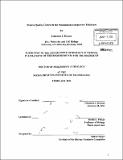Protein quality control in the mammalian endoplasmic reticulum
Author(s)
Klemm, Elizabeth J. (Elizabeth Joanna)
DownloadFull printable version (19.47Mb)
Other Contributors
Massachusetts Institute of Technology. Dept. of Biology.
Advisor
Hidde L. Ploegh.
Terms of use
Metadata
Show full item recordAbstract
Quality control is an important part of protein biogenesis. Aberrant proteins must be destroyed before they aggregate and cause deleterious effects. Failure to do so can result in cell death or malfunction and, ultimately, disease. Quality control involves the recognition of misfolded proteins and their degradation. For secretory and membrane proteins, folding occurs in the endoplasmic reticulum (ER), but degradation is performed by the cytosolic proteasome. Thus, quality control in the secretory system includes the dislocation of misfolded proteins from the ER to the cytoplasm. ER proteins that fail to fold correctly are identified and directed to the membrane-associated ER quality control machinery. They are then moved across the ER membrane, tagged with ubiquitin, and extracted from the membrane and complex. Finally, the dislocation substrate is taken to the proteasome where it is degraded. Many proteins constituting the mammalian quality control machinery have been identified. Several different dislocation complexes work in parallel to clear misfolded proteins from the ER and they are distinguished by their E3 ubiquitin ligase. This thesis describes the identification and characterization of several previously unknown members of the HRD1-associated ER quality control complex. The newly-identified proteins are osteosarcoma amplified-9 (OS9), UBX domain containing-8 (UBXD8), Ubiquitinconjugating enzyme-6e (UBC6e), and ancient ubiquitous protein-i (AUP1). Each of these proteins participates in different steps of ER quality control. OS9 directs misfolded soluble glycoproteins to the dislocation complex. The mannose-6- phosphate homology domain of OS9 is involved in the recognition of glycans on the misfolded protein. UBXD8 recruits p97, the AAA+ ATPase responsible for membrane extraction of dislocated proteins, to the ER using its UBX domain. UBC6e is a membrane-anchored E2 ubiquitin conjugating enzyme. AUP1 recruits a second E2, soluble UBE2G2. Additionally, AUPI regulates substrate mono- and poly-ubiquitylation. AUPI is also necessary for lipid droplet formation. Lipid droplets are cytoplasmic organelles that store neutral lipids. Based on the data that AUPI depletion affects both ER quality control and lipid droplet formation and that pharmacological inhibition of lipid droplet formation perturbs dislocation, we propose that lipid droplet formation may also play a role in ER protein quality control.
Description
Thesis (Ph. D.)--Massachusetts Institute of Technology, Dept. of Biology, 2011. Cataloged from PDF version of thesis. "February, 2011." Includes bibliographical references.
Date issued
2011Department
Massachusetts Institute of Technology. Department of BiologyPublisher
Massachusetts Institute of Technology
Keywords
Biology.